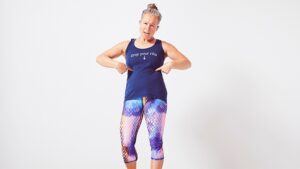Tired of feeling like your pelvic floor is holding you hostage? If you’re an active person (or you’d like to be), dealing with pelvic pain, hip pain, sneeze pee, diastasis recti, prolapse and other pelvic floor issues can be a real downer. I’ve been there myself – and I want you to reclaim the activities you love, and more, just like I did. That’s why talking about pelvic floors is one thing I’ll never get tired of!
For a long time, Kegels have been the go-to exercise to heal pelvic floor issues. But they’re not the only option. In fact, they might not even be the right option for many of us. (I’ve written about why Kegels might not be the best solution for everyone here.)
Pelvic floor health is about how your whole body moves, including your breathing mechanics, your core engagement, and how well and how often you sit, squat and walk each day. A spot treatment like Kegels misses all that juicy big picture stuff. For a better long term solution, you need to think about how you move your whole body to nurture better pelvic floor health.
That’s why I created two Pelvic Floor+ programs: Pelvic Floor+ Upper Body and Pelvic Floor+ Lower Body (click here to read more and sign up!). But for right now, I’ve put together a checklist (plus links to free resources) to help you assess the movement patterns and habits that could be affecting your pelvic floor.
Pro tip: Even if your pelvic floor is happy right now, these 18 tips are worth considering – they’re all foundational to optimal movement.
#1 How Does Your Ribcage Align Over Your Pelvis
Lifting your rib cage is what we’re taught is ‘good posture’, but it could contribute to poor core function and limited breathing patterns, leading to back pain and pelvic floor issues. Here’s more info on where your ribs should live for a happy spine and pelvic floor. Plus it’s actually the first step to getting good posture in a way that’s good for your body, long term.
You might also wanna check out this free, 5-part video series, Ribcage Magic, for more tips on ribcage alignment.
#2 Do You Breathe Primarily Into Your Belly Or Upper Chest?
Breathing into your entire ribcage reduces pressure on the pelvic floor muscles, but a lot of us struggle to do this. Check out this video for tips on how to breathe in a way that nurtures your core & pelvic floor!
#3 How Tight Are Your Shoulders And Upper Back?
Tightness & tension in your shoulders and upper back have a major impact on your breathing and therefore, on core function. Our bodies work as a system! If you have tight shoulders, then getting them moving better should definitely be on your pelvic floor care checklist.
Fun fact: shoulder function can also be linked to pelvic floor function – this study found that our pelvic floors actually engage reflexively when we use our deltoid shoulder muscles.
If you have a little more time and you’d like to learn one of my favourite routines to improve shoulder mobility, watch this Kinstretch class on improving your shoulder rotation and mobility.
Start healing your pelvic floor, building a functional core & caring for your spine (for free!)
#4 Do You Constantly Brace Or Suck In Your Stomach Muscles?
Sucking in your belly is super common – many of us have even been taught that it’s what we should be doing full time.
But it’s really unhelpful long term – in fact, this habit messes up core function (actually creating less stability!), changes our breathing mechanics, weakens the pelvic floor and generally wreaks havoc with everything between our neck and pelvis. In this video, I break down how we want our cores to work and the foundational belly release exercise that will help improve your pelvic floor function.
#5 Do You Strain On The Toilet?
I may be alone in my desire to talk toilet habits, but constipation is a major contributor to pelvic floor problems because of the excess pressure needed to poop (#SorryNotSorry). The good news is that this can often be resolved through diet, hydration and better movement habits (including getting our ribs down like in #1 above, and not sucking in our bellies!). Abdominal twisting and learning to release core tension can also be super effective for getting things moving. As can a toilet stool like the Squatty Potty! Want a bit more info? Check out this IG post.
#6 Are You Feeling Stressed And Anxious?
Did you know that your pelvic floor responds to scary movies? A study found that when women were shown a threatening film, their pelvic floor muscles contracted. The same defence mechanism can be at play when we feel life stress or anxiety. Constantly tight muscles can’t actually do their job. So, reducing stress needs to be a priority for pelvic floor health as well as mental health. Another benefit? Often, reducing stressors can help our bodies experience less pain.
#7 Do You Have A Pelvic Floor Gripping Habit?
Lots of us hunch up our shoulders, grip our butts, or clench our jaws – all of these are tension habits that don’t serve us well long term. Well, guess what – lots of us clench our pelvic floor muscles too. Whether it’s about anxiety, simply a habit, or our body’s attempt to stabilize our core, it’s not great for pelvic floor function!
For optimal function, we need these muscles to be able to relax and lengthen as well as shorten. My courses on pelvic floor health – Pelvic Floor+ Upper Body and Pelvic Floor+ Lower Body dive into these issues and how to address them in more detail. Click here to read more about both programs!
#8 Do You Hold Your Breath When Lifting Stuff Or Loading Your Core?
This is a sign you’re using pressure to stabilize your core. Using pressure to stabilize can be really useful – but it shouldn’t be our only strategy! When we use too much pressure, too often, to get life done, this strategy can overload our pelvic floor muscles. If you catch yourself holding your breath every time you lift things or do core exercises, consider it a sign that your core function may not be optimized. Remember to breathe and consider taking a course like Pelvic Floor+ so you can learn to use your core in a more healthy and functional way!
#9 How Do You Use Your Core To Stabilize?
Holding our breath is one way to engage our core that may not be helpful – but there are a few other ways that are also not ideal. Overgripping our upper abs, over-bracing, or ‘bearing down’ (a bit like when you’re on the toilet) are all common stability strategies that aren’t necessarily helpful. I’m a bit of an ab gripper myself – my obliques and six pack muscles like to overwork – which tends to put a lot of downward pressure on my pelvic floor.
Instead of using pressure strategies, aim to build a responsive core that can move and adapt to keep our bodies stable as we move through our day, and relax when tension is no longer needed.
Start healing your pelvic floor, building a functional core & caring for your spine (for free!)
# 10 Do You Sit For Long Periods? When You Sit, Is Your Low Back Rounded And Your Pelvis Tucked Under?
Our core & pelvic muscles don’t function as well when we sit in a tucked pelvis. Which is how most of us sit most of the time, which may be a clue about why soooo many people end up withe pelvic floor issues. Learn to sit with a neutral pelvis to keep your core, pelvic floor, spine & SI joints happier!
Pro tip: Sitting in chairs encourages pelvic tucking and it also limits our daily movement and hip mobility options. Check out this floor sitting blog post for my favourite way to nourish your hips, pelvic floor & core strength with zero extra time required.
#11 How Much Do You Walk? How Often? Wearing What Shoes? On What Surfaces?
If I ever do a TED Talk, it’ll most likely be about the wonders of walking. Frequent walking with toe boxed, flat soled shoes is an ideal way to get strong, functional pelvic muscles (and many more whole-body benefits besides). Here’s my complete guide to transition to minimalist shoes, if this is new to you.
#12 Can Your Feet Both Pronate And Supinate?
The way you walk has a domino effect from your feet all the way up through your knees and hips to your pelvic floor. That’s why the shoes you wear matter – conventional shoes change our walking mechanics and our pelvic floors suffer as a result. When our feet can twist and untwist during our walking (aka pronate and supinate), it means our hips rotate correctly – and our hip rotator muscles are actually part of our pelvic floor muscles. Switching to minimal shoes can allow our feet to access pronation and supination mechanics. But the truth is, most people need to spend some time restoring their midfoot mobility and pronation and supination mechanics. This exercise is a good first step for both – and there’s a lot of essential work on this in my program – Pelvic Floor+ Lower Body (click here to read more about the program).
#13 Can You Extend Your Legs Behind Your Pelvis (AKA Hip Extension)?
Answer: Almost certainly not enough! Most people struggle with hip extension because of our shoes and chairs, but it’s often key to helping the pelvic floor muscles get the movement inputs they need! This lunge is a super effective tool for restoring hip extension. Bonus: you might also uncover some interesting one sided body patterns that can contribute to SIJ and pelvic floor issues!
#14 Do You Spend Time Each Day In A Squat Position?
A great squat can take pelvic floor muscles through a full range of motion – including a nice long stretch when your pelvis is fully untucked. In fact, However most of us in the West have lost our capacity to access a full resting squat – which includes time with an untucked pelvis getting up and down. If you struggle to keep your heels down or you wobble when you squat, here’s a gentle way to get the benefits of squatting that works for most bodies – give it a go!

#15 How’s Your Hip Mobility?
How tight are your hips, hamstrings and inner thighs? Persistent tightness in any or all of these muscles often correlates with pelvic floor issues. Try this hip hinge double-calf stretch to start restoring juice to those hips & hamstrings (and learn a key movement skill while you’re at it – this one will support you squatting, your untucked pelvis sitting, and all your future work on hip mobility!)
Start healing your pelvic floor, building a functional core & caring for your spine (for free!)
#16 How Do You Stand?
Like the way you sit, the way you stand has a big impact on pelvic floor muscles – which is a big reason why “hips over heels” is one of my favourite movement mantras! Almost all the people I see around me love to stand with their pelvis pushed too far forward – which compresses & shortens PF muscles (including me back when I first started learning about movement!). Learn to stand hips over heels and you’ll be nourishing your pelvic floor all day, every day!
#17 Do You Have Strong Lateral Hip (Side Butt) Muscles?
The muscles that lift your leg out to the side play a major role in walking well and supporting pelvic floor function. But it’s kind of backwards, because when you walk, instead of pulling your leg to the side, those same muscles actually stabilize your pelvis and lift your other leg up off the ground. This requires strong lateral hips: your TFL, glute med, and piriformis all get involved here.
If you’ve never tried using your lateral hips in this way, it can be confusing at first. As an exercise, I call it the pelvic list (like a ship, listing from side to side). This listing tutorial will help you get started.
#18 How Mobile Is Your Spine?
Last but not least, let’s check out your spinal mobility. Sticky spines prevent optimal core function and restrict your breathing, causing back pain and pelvic floor issues. Check out this class for 3 delicious ways to improve your spinal mobility.
My course on pelvic floor health (which is really about how whole-body movement can support a strong and functional pelvic floor) covers all of this and more. Click here to read more about the Pelvic Floor+ program.
In the meantime, you can start laying the groundwork today with Ribcage Magic, a free 5-part video series to help you master one of the most important first steps for pelvic floor health.
Pick up Ribcage Magic for free today and take the first step towards whole-body movements that nourish your pelvic floor for a lifetime
Ready to live freely and transform your pelvic floor health?
Be the first to know when Pelvic Floor+ goes on sale this summer!







